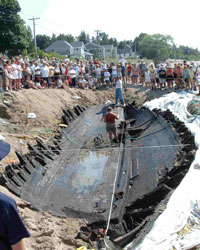 As a marine archaeologist, Trent alumnus Mr. Ken Cassavoy has a fascinating job piecing together history while combining two of his passions — diving and archaeology. Perhaps the most significant site he has worked on is the HMS General Hunter, which is about to become the centrepiece of an exhibit at the Bruce County Museum in Southampton, on June 18, 2012 – the 200th anniversary of the U.S. declaring war on Britain.
As a marine archaeologist, Trent alumnus Mr. Ken Cassavoy has a fascinating job piecing together history while combining two of his passions — diving and archaeology. Perhaps the most significant site he has worked on is the HMS General Hunter, which is about to become the centrepiece of an exhibit at the Bruce County Museum in Southampton, on June 18, 2012 – the 200th anniversary of the U.S. declaring war on Britain.
The exhibit will include a replica of the deck of the vessel where visitors can participate in a mock cannon-firing sequence, a sail-raising experience and a ship-steering activity. As well, the flag the HMS General Hunter was flying during the Battle of Lake Erie – on loan from the U.S. Naval Academy Museum - will be part of the exhibition.
While all the artefacts, such as the swivel-cannon, military buttons, ship fasteners, ceramic and glass pieces, have been lifted from the wreck and will be on display in the exhibit, the ship’s hull remains buried in the sand, where it is stable and safe. Removing the hull, after the wood has been so water- logged, will cause what remains to rapidly deteriorate.
The HMS General Hunter was built for the Provincial Marine at Amherstburg, Upper Canada, and launched in 1806. During the War of 1812, the ship was involved in the Battle of Lake Erie in September 1813, during which six British ships engaged nine American counterparts. The British lost the battle, and the HMS General Hunter was captured by the Americans. After the war, the ship served as a U.S. Army transport vessel, her name shortened to Hunter.
During a violent storm in 1816 on Lake Huron, while Hunter was sailing from Michilimackinac to Detroit, the crew made the life-saving decision to run the ship towards the sandy beach of Southampton, Ontario. Buried under the Lake Huron beach at Southampton, the Hunter slept quietly, while visitors and residents walked on, ran and played, unknowingly, over the historical artefacts.
“No one knew the ship was there,” Mr. Cassavoy said, “until some frame tips started showing up through the sand on the beach. It was obvious it was a ship but we had no idea what ship it could be. There have been quite a few wrecks found in this area.”
An initial excavation revealed the ship was apparently quite old, and, because of its age, a significant piece of history. In 2004, Mr. Cassavoy and his team from the Ontario Marine Heritage Committee and the Southampton Marine Heritage Society completed a full excavation of the interior of the ship.
“We found a small swivel cannon lying up against the keelson in the bottom of the ship,” Mr. Cassavoy recalled. “It’s very unusual to find cannons on ships in the great lakes. This discovery was both interesting and very dramatic.” Based on the hull construction and the artefacts found, Mr. Cassavoy and his team knew they had a military vessel from the late 18th or early 19th Century. Now they knew the type of vessel, but her name was still a mystery.
Using research funding, including funding from the Symons Trust Fund, Mr. Cassavoy began an investigation into the identity of the wreck. Important details of the ship were uncovered in the U.S. National Archives in Washington. Remarkably, a complete story of the demise of the ship was documented by the crew and master of the Hunter, and was preserved in the National Archives. “It’s very unusual to have the end of the story,” Mr. Cassavoy said. “Once we had this information we started making progress on telling the Hunter’s story. And now, we are preparing to build a major exhibit.”
Mr. Cassavoy graduated from Trent in 1976 with a degree in Anthropology. “Trent was a relatively new University at the time,” he recalled, “but was building a great reputation for itself. I had the pleasure of meeting Professor Tom Symons, and taking a history course with him. He was very inspirational and played a big role in my decision to continue to pursue my studies.
“I was a diver,” Mr. Cassavoy said, reflecting on how he began his career in nautical marine archaeology. “But I was interested in more than just going out diving. Professor Richard Johnston was a great mentor to me during my undergraduate degree at Trent. He helped me see that I could combine diving with archaeology, and helped me fund a research trip to a nautical site in Orillia. I was taken with the entire process. It was so interesting.” Mr. Cassavoy said that encouragement and support from faculty helped him obtain his goals, and he mentioned the Trent University Archaeological Research Centre (TUARC) as proving to be an excellent resource throughout his career.
At the time, there were few accredited archaeologists working in this specialized field. Mr. Cassavoy recognized the importance of pursing his academics, and after graduating from Trent he attended Texas A & M University, the hub of nautical archaeology, to obtain a postgraduate degree.
Mr. Cassavoy currently lives and works in Southampton, the site of the HMS General Hunter. Located on Lake Huron, it is the location of dozens of shipwrecks, providing him with plenty of opportunities for marine archaeological research.
Posted on Monday, April 2, 2012.


































